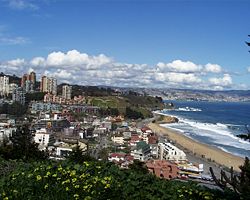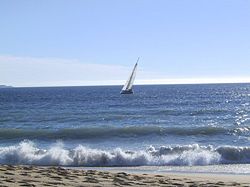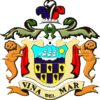Viña del Mar
| Viña del Mar | |||
|
|||
| Nickname(s): "Ciudad Jardín" | |||
 |
|||
 Viña del Mar
|
|||
| Coordinates: | |||
| Regions | Chile | ||
|---|---|---|---|
| Regions | V - Valparaiso Region | ||
| Viña del Mar | May 31, 1878 | ||
| Government | |||
| - Mayor | Virginia Reginato Bozzo (UDI) | ||
| Population (2002) | |||
| - Total | 286,931 | ||
| - Density | 2.359/km² (6.1/sq mi) | ||
| Time zone | n/a (UTC-4) | ||
| - Summer (DST) | n/a (UTC-3) | ||
| Website: Ilustre Municipalidad de Viña del Mar | |||
Viña del Mar (Spanish: "Vineyard of the Sea"), also known locally as La Ciudad Jardín (Spanish: "The Garden City"), is a Chilean commune and coastal city in Valparaíso Province, Valparaíso Region. With a population of 286,931 (2002 census), it makes Chile's fourth largest city. It is also part of the Greater Valparaíso area, the country's second largest conurbation (pop. 803,683, 2002 census), which includes nearby Valparaíso and other cities.
Viña del Mar is best known as a tourist and beach destination (with multiple beaches including Reñaca, Las Salinas, Miramar, Casino, and others). One of its key attractions are a gambling casino and a yearly music festival, Festival Internacional de la Canción de Viña del Mar (Spanish: "Viña del Mar International Song Festival") that is hosted in the Quinta Vergara Amphitheater. The city also hosts a yearly ATP clay-court tennis tournament (Movistar Open).
Contents |
History
The valley where Viña del Mar was founded was known as the valley of Peuco by the Changos, native inhabitants of the area dedicated to fishing. With the arrival of the Spanish conquistadores the valley was divided into two large haciendas. North of the Marga Marga creek up to the current location of Reñaca, Viña del Mar, and to the south up to the current Cerro Barón (Baron Hill), the Hacienda Las Siete Hermanas (The Seven Sisters).
Francisco Javier Álvarez authorized the construction of a railroad through his lands to join Santiago and the port of Valparaíso. The arrival of the railroad brought a young engineer Jose Francisco Vergara who married Francisco Javier Álvarez’s granddaughter, Mercedes Álvarez. It was José Francisco Vergara who instigated the idea of the creation of a new city independent of Valparaíso. Finally on May 30 1878 the Chilean government authorized the creation of the new city of Viña del Mar.
In 1892 Salvador Vergara (son of José Francisco Vergara) commenced the development of the north bank of the Marga Marga creek under the name of Población Vergara, around the current Avenida Libertad(Liberty Avenue).
The establishment of Refinadora de Azúcar de Viña del Mar (Sugar Refining Company), CRAV in 1873 and the arrival of the British company of Lever & Murphy in 1883 gave the necessary economic push to transform the young city into one of the most important cities of Chile. The building of a military installation, Regimiento Coraceros in 1917, naval facilities in Las Salinas, and the housing of military and naval personnel furthered the city's growth. In 1925 the Teatro Municipal was opened in its current location in the eastern front of the city's downtown square, Plaza de Viña del Mar. In 1928 president Carlos Ibáñez del Campo authorized the creation of a casino, securing the future and the touristic character of the city. The Casino Municipal de Viña del Mar was opened on December 31, 1930. On January 31, 1931 the Presidential Palace was inaugurated in Cerro Castillo (Castle Hill) as a summer residence for the Chilean President. The touristic character of the city was furthered with the inauguration of the O'Higgins Hotel in 1936 and the inauguration of the Miramar Hotel by Caleta Abarca Beach in 1945. Later a number of small industries settled in the eastern part of the city, bordering the Marga Marga creek in El Salto, including a Coca-Cola bottling facility, meat processing facilities, and chemical factories.
Viña del Mar was one of the four host cities of the 1962 football (soccer) World Cup. It is now home to CD Everton, a soccer team in the Chilean Premier division, which took its name from the English team.
Viña del Mar was declared a sister city of Sausalito, California (a city north of San Francisco), in 1971. To demonstrate the sister city relationship, you can find a square (plaza) called "Viña del Mar" in downtown Sausalito, and a "Sausalito" stadium and "Sausalito" lagoon in Viña del Mar. Viña del Mar is also a sister city of Mar del Plata, Argentina since 1993. There are intentions to create such relationship with Guangzhou, China.
During the 1980s a global economic downturn seriously affected the city, a number of small and medium sized factories went bankrupt, including the stationery manufacturer Coda, and most importantly, CRAV, and Textiles Viña, two of the biggest employers in the city. Unemployment rose to alarmingly high rates and the military government of General Pinochet failed to take effective measures to combat unemployment. Many factories started to consolidate their operations in Santiago making the situation even worse. The city has failed to fully recover from the blows inflicted by the economic downturn of 1982, but an increase in the number of international tourists visiting the city, and the recent high prices of copper in world markets have promoted an economic recovery.
Extensive commercial remodelation in the 15 Norte Avenue area, previously an abandoned industrial area, has seen most of the large Chilean retail chains settling in the area, which is now covered with large shopping malls, like Marina Arauco, cinemas, fast food stores, and supermarkets.
The city has benefitted from major investments in infrastructure that have greatly improved the traffic flow in the downtown area, especially in routes connecting Viña del Mar with Santiago, Valparaíso and Quilpue. A modern and efficient subway (Merval) connects Viña del Mar with the cities of Limache and Valparaiso, following the original railroad tracks between Valparaiso and Santiago.
City landmarks




Visitors and locals enjoy the parks and water fountains of the city, including a large flower clock (Reloj de Flores) with its numbers made up of flowering plants, near Caleta Abarca beach and Miramar Hotel. The Valparaiso Sporting Club horse racing track is another major landmark. Jardín Botánico or Parque del Salitre, a rather large botanical garden on the outskirts of the city, was originally designed and built by an entrepreneur who got rich from exploiting saltpeter resources in northern Chile.
A few buildings from the 1800s still remain after multiple earthquakes that have destroyed most of the old areas of the city. Most of the older buildings that remain are located along Avenida Libertad (Liberty Avenue), Quillota Street and Quinta Vergara, a rather large park in the middle of the city. The presidential summer residence, Castillo Presidencial (Presidential Castle) is located on Cerro Castillo (Castle Hill).
The city's gambling casino is the oldest in Chile and also the most visited and luxurious. The casino was designed with art deco style and is surrounded by well-tended gardens (hence the city's nickname). In 2002 a hotel (Hotel del Mar) was added to the 1930s building, resembling the architectural features of the original building.
Palacio Rioja, a magnificent mansion built by Fernando Rioja in 1907, located on Quillota Street, houses an environmental museum. The Fonck Museum, located in Cuatro Norte Street, has a large exhibition of pre-Columbian articles, and a large moai (Easter Island statue made of volcanic rock), the only one in mainland Chile, is also on display. Palacio Carrasco, built by Emilio Carrasco in 1912, now houses the Municipal Library and also is used for arts exhibitions. The building is also surrounded by nice gardens adorned with fine sculptures including a Rodin. Palacio Vergara located in Quinta Vergara was built by Blanca Vergara (daughter of José Francisco) in 1906 and it is now owned by the municipality. It currently houses the School of Fine Arts and has produced important Chilean artists like the painter Giancarlo Bertini.
Palacio Brunet (also known as "Castillo Yarur") was built in 1923 by Adolfo Brunet on Cerro Castillo, close to the presidential mansion. Currently it is owned by Carabineros de Chile (Chilean police) and is used as a reception center for illustrious visitors. It was declared a national monument in 2005.
Numerous bars and restaurants have recently opened in the area around Plaza México and Avenida San Martín, offering Chilean and international cuisine. Seafood restaurants are located on the Camino Costero (Coast Roadway) that joins Viña del Mar and Con-Cón, a coastal town to the north.
Education
Several educational institutions are located in the city such as Universidad Adolfo Ibáñez and the School of Architecture of the Pontificia Universidad Católica de Valparaíso, PUCV (Pontifical Catholic University of Valparaiso), both located in the beach-suburb of Recreo. The PUCV's Faculty of Education is located in Sausalito near the lagoon of the same name. Also, the Universidad de Valparaiso has campuses in the city such as the one housing faculties of Marine Sciences and Engineering. The Universidad de Viña del Mar, a private university, has a number of campuses across the city. There is also the most prestigious University in Latin America 'Federico Santa Maria Technical University' Universidad Tecnica Federico Santa Maria located in Valparaiso city and one of the Campus 'Jose Miguel Carrera' located in Viña del Mar.
There is a number of private secondary schools, such as Liceo Parroquial San Antonio, The Mackay School, Colegio Sagrados Corazones (Sacred Hearts School), Colegio Hebreo (Hebrew School) Colegio Seminario San Rafael(Saint Raphael Seminary School) and The Pan-American College, the latter in the suburb of Miraflores Bajo.
The Chilean Navy (Armada de Chile) also operates several technical schools and a planetarium in Las Salinas, at the northwest edge of the city.
Notable residents
The city is the birth place of Alberto Hurtado, the second Chilean Catholic saint and founder of the Hogar de Cristo (Home of Christ) foundation, writer Maria Luisa Bombal, the author of La Ultima Niebla (The Last Fog), former Chilean president Patricio Aylwin, tennis player Nicolás Massú and Slayer vocalist Tom Araya.
Gallery
External links
- Municipality site
- VIña del Mar commercial guide
- Castillo Wulff (Museo del Mar)
- Palacio Presidencial
- Plaza Viña del Mar at Sausalito, California
- Municipality of Viña del Mar
- Live webcam from Viña del Mar
- Quinta Vergara Park
| Greater Valparaíso | |
|---|---|
| Cities | Valparaíso | Viña del Mar | Concón | Quilpué | Villa Alemana |
| Universities | Pontifical Catholic University of Valparaíso | Federico Santa María Technical University | University of Valparaíso | University of Educational Sciences "Playa Ancha" |
| Culture & Sports | El Mercurio de Valparaíso | Santiago Wanderers |
|
|||||||||||||||||||||||

